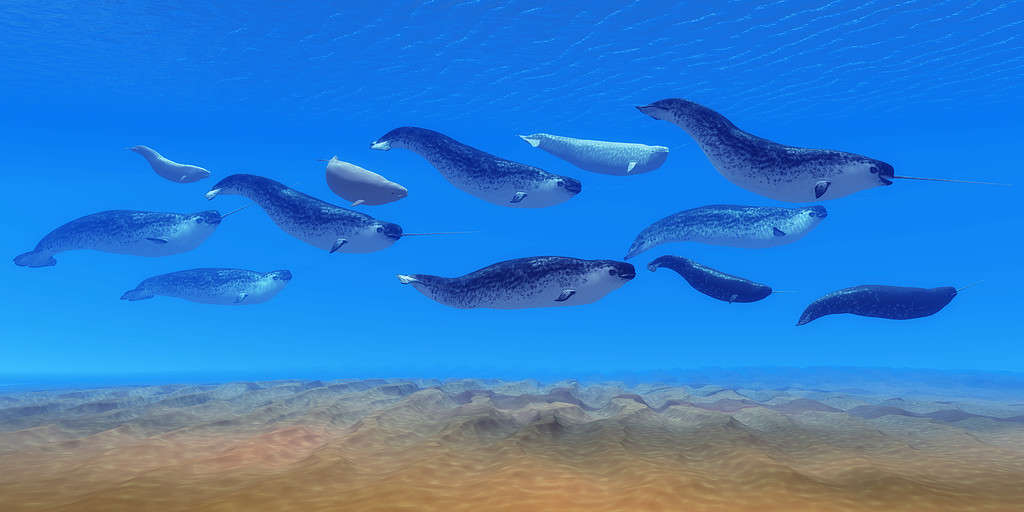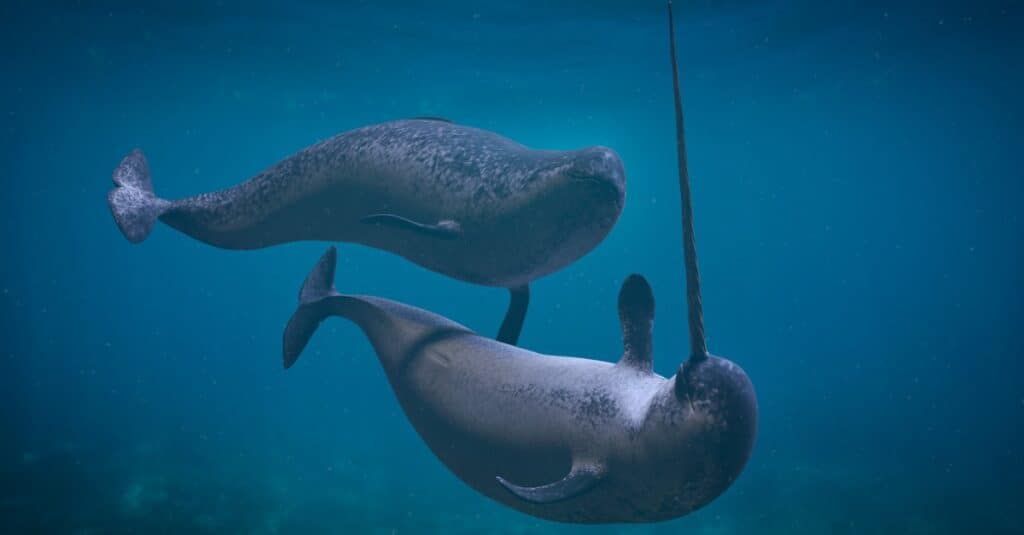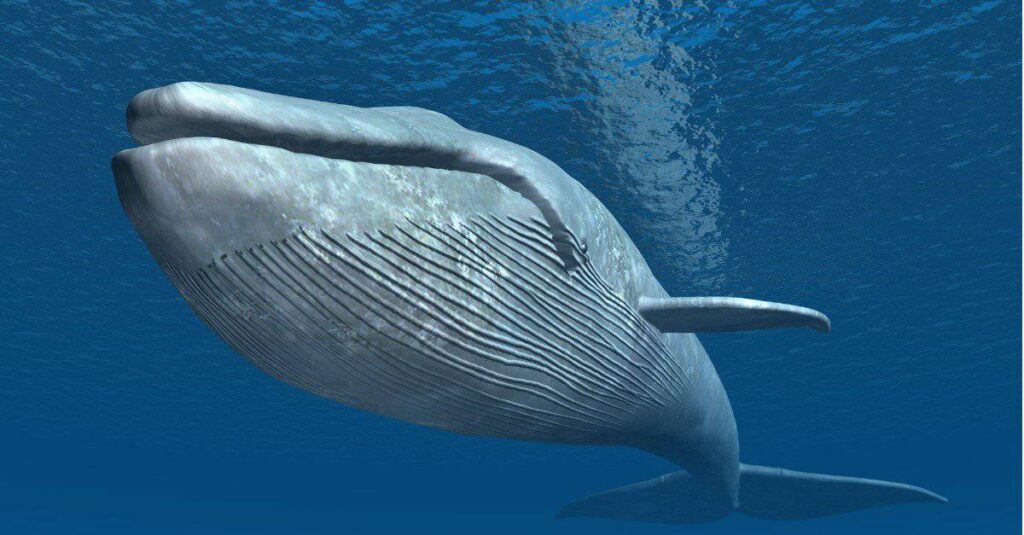Welcome to our article on narwhal size comparison! Have you ever wondered just how big these magnificent creatures can get? We will explore the impressive dimensions of narwhals and compare them to other animals and objects. Prepare to be amazed as we delve into the world of these elusive marine mammals and uncover fascinating facts about their extraordinary size. Whether you’re a nature enthusiast or simply curious about the wonders of the animal kingdom, join us on this journey as we unravel the mysteries surrounding narwhal proportions. Get ready for some jaw-dropping comparisons that will leave you in awe!
Narwhal Overview

Scientists have many theories about the purpose of a narwhal’s long tusk.
©iStock.com/dottedhippo
A narwhal, often referred to as the “unicorn of the sea,” is a fascinating marine mammal known for its unique physical appearance. The scientific name for narwhal is Monodon monoceros. Some people call them narwhales.
In terms of physical appearance, narwhals possess a long tusk protruding from their upper left canine tooth. This spiral-shaped ivory tusk can grow up to 10 feet in length and is primarily found in males. However, fifteen percent of females may also develop smaller tusks. These majestic creatures boast sleek bodies that range in color from mottled gray to bluish-black on their dorsal side and exhibit lighter shades on their ventral side.
Narwhals are carnivorous creatures. Their primary food source consists of various species of fish. They eat cod, halibut, Arctic char, squid, and shrimp, along with other small crustaceans present within the icy waters they inhabit. Narwhals use echolocation skills by emitting clicks or whistles through their nasal passages. They use phonics lips located near their blowholes to locate these prey items accurately.
Narwhals predominantly inhabit Arctic waters and are commonly found throughout Canada’s eastern regions, including Greenland and Russia’s northern coastlines. They tend to favor areas characterized by pack ice during colder months. Then they migrate towards more open water regions during summer seasons when ice retreats. These intelligent creatures frequently navigate areas filled with fjords or coastal bays.
Narwhal Size at Birth

Narwhal whales live in social groups called pods and live in the Arctic Ocean, and males have a tusk.
©Catmando/Shutterstock.com
During the early years of their lives, narwhals experience significant milestones that shape their growth and development. Female narwhals typically reach reproductive maturity between the ages of six to eight. It is at this point in their lives that they begin bearing calves, an extraordinary event that occurs during specific periods in the calendar year.
Adult narwhals engage in mating rituals during April or May. They do this by gathering within the vast expanse of offshore pack ice. This icy environment provides a unique backdrop for these majestic creatures to find suitable partners and initiate the process of reproduction. Following successful mating, female narwhals experience a gestation period lasting approximately 14 months.
The incredible journey of pregnancy culminates with the birth of newborns between June and August of the subsequent year. Similar to many other marine mammals, narwhals give birth to only one offspring at a time. These newborns make quite an entrance into the world. They measure at an average length of 5.2 feet and showcase a striking white or light grey coloration. The day they are born, they weigh 180 pounds!
As with any young mammal entering life’s realm, newborn narwhal calves possess certain adaptations that aid their survival from day one. They are equipped with a thin layer of blubber which serves as insulation against frigid waters. It also provides buoyancy as they navigate through their aquatic habitat. Over time, this initial layer thickens gradually as they nourish themselves solely on their mother’s milk. Narwhal milk is a rich source of fat essential for their growth and development.
Narwhal Size When Mature

A narwhal’s horn is actually a tooth with millions of nerve endings.
©iStock.com/dottedhippo
Narwhals, known for their distinctive tusks, are medium-sized whales that bear a striking resemblance to beluga whales in terms of size. When fully grown, both male and female narwhals measure between 13 to 18 ft in length, excluding the impressive tusk. However, there is a slight disparity in size between the two sexes. On average, males tend to be slightly larger than females, with an average length of around 13.5 ft compared to the average length of approximately 11.5 ft for females.
In addition to their lengths, adult narwhals also exhibit variations in weight. These majestic creatures typically weigh anywhere from 1,760 lbs to 3,530 lbs when they reach maturity. It’s fascinating how these gentle giants can vary significantly in mass while still maintaining similar overall dimensions.
When it comes to sexual maturation among narwhals, there are notable differences between males and females regarding age and size milestones. Male narwhals usually attain sexual maturity at around 11 to 13 years old—a time when they typically measure about 12.8 ft long—before embarking on their reproductive journey.
On the other hand, female narwhals reach sexual maturity at a younger age range of about five to eight years old. During this period of development and growth, they generally measure around an approximate length of 11.2 ft.
Narwhal Size Comparison to a Killer Whale

Orcas are the largest species of dolphin. They can weigh as much as 13,000 pounds.
©Willyam Bradberry/Shutterstock.com
The killer whale or orca is one of the largest members of the dolphin family. These majestic animals exhibit remarkable intelligence and complex social structures within the pods that they reside in. Male killer whales typically grow much larger than females. They reach an average length of about 25 feet and weigh up to a staggering 6 tons. Their average weight is between 8 and 13 thousand pounds! Female killer whales generally measure around 23 feet and weigh between three to eight thousand pounds.
Comparing these two magnificent species reveals some interesting differences in size between them. While male orcas clearly surpass male narwhals in terms of length and weight by several feet and tons, female narwhals more closely match female orcas when it comes to overall dimensions.
Narwhal Size Comparison to a Great White Shark

The
great white shark
is the largest predatory fish on earth.
©Wirestock Creators/Shutterstock.com
When it comes to comparing the size of a full-grown narwhal, one cannot help but wonder how it measures up against the mighty great white shark. Narwhals’ average length ranges between 13 and 18 feet. And weighing anywhere from 1760 to 3530 pounds, these majestic creatures possess an undeniable presence in the frigid waters they inhabit. But how does their stature fare when pitted against that of a great white shark?
The great white shark, a formidable predator of the sea, starts its life measuring around 4 feet in length. As it matures, this magnificent creature has the potential to reach an astounding size of approximately 20 feet long. They can weigh over 4,000 pounds! Surprisingly enough, these dimensions are quite comparable to those of a fully-grown narwhal.
These two animals differ drastically in appearance and behavior. The powerful torpedo-shaped body and razor-sharp teeth characteristic of the great white contrast starkly with the sleek form and majestic tusk sported by its Arctic counterpart. They share a common prowess when it comes to physical magnitude.
Narwhal Size Comparison to a Bottlenose Dolphin

Dolphins weigh considerably less than narwhals.
©slowmotiongli/Shutterstock.com
Narwhals and bottlenose dolphins differ noticeably in size. When comparing the lengths of these majestic creatures, narwhals typically measure 13-18 feet long, while bottlenose dolphins fall within a range of 6-12 feet. This significant difference implies that narwhals can reach nearly twice the length of their dolphin counterparts.
Furthermore, weight serves as another differentiating factor between these marine mammals. Narwhals exhibit a substantial mass, ranging from an impressive 1760 to 3530 pounds. Conversely, bottlenose dolphins weigh significantly lighter at approximately 331 to 442 pounds on average.
Despite these disparities in size and weight, both species share several intriguing similarities beyond their classification as cetaceans. Both narwhals and bottlenose dolphins are highly intelligent creatures renowned for their complex social structures and advanced communication skills. Additionally, they thrive in aquatic environments but inhabit diverse regions across the globe.
Narwhal Size Comparison to a Human

One narwhal is longer than three adult human males laid end to end.
©iStock.com/Vac1
In terms of size, narwhals are truly impressive creatures. When comparing their length and weight to that of a human, the differences become even more astonishing. These majestic marine mammals can reach weights ranging from 1760 to 3530 pounds, far surpassing the average weight of a human male, which stands at around 197 pounds.
But it’s not just their weight that sets them apart. Narwhals also exhibit remarkable lengths. Stretching out in all its glory, a fully grown narwhal measures anywhere between 13 to 18 feet in length. In contrast, the average height of a human male is approximately five feet nine inches.
Narwhal Size Comparison to an African Elephant

An
African forest elephant
can weigh as much as 12,000 pounds. This is 3.4 times the weight of a narwhal.
©iStock.com/USO
Let’s consider the size of a narwhal in relation to an African forest elephant. A narwhal typically measures between 13 and 18 feet in length. While an African forest elephant spans approximately 10 feet from head to rump. Although both animals possess remarkably elongated appendages!
In terms of weight, a narwhal generally ranges from 1760 to 3530 pounds, showcasing its impressive bulk. On the other hand, an African forest elephant outweighs its marine counterpart. With a substantial range of approximately 4000 to 12,000 pounds.
Despite their disparities in size and habitat preferences, both creatures boast captivating attributes that contribute to their allure among wildlife enthusiasts worldwide. The enchanting spiral tusk adorning a narwhal’s snout serves as an emblematic feature cherished by researchers and admirers alike. Similarly striking is the magnificent trunk possessed by an African forest elephant. An incredibly versatile organ enabling various functions such as feeding, communication, and even defense.
Narwhal Size Comparison to a Blue Whale

The 300,000-pound
blue whale
weighs 85 times more than the largest of narwhals.
©iStock.com/MR1805
When it comes to comparing the size of a blue whale and a narwhal, there is quite a significant difference. While narwhals typically measure between 13 to 18 feet in length, blue whales can reach astonishing lengths of up to 100 feet! This stark contrast makes the blue whale the largest creature on Earth, dwarfing the relatively smaller narwhal.
Not only do their sizes differ dramatically, but their weights also showcase an immense variation. Narwhals weigh approximately 1760 to 3530 pounds, which may seem substantial when compared to other marine animals. However, it pales in comparison to the colossal weight carried by blue whales. These majestic giants can tip the scales at an astounding range of 200,000 to 300,000 pounds! A blue whale’s tongue alone weighs more than an entire narwhal’s body. Wow!
What is a Narwhals Tusk For?

Scientists believe that the narwhal tusk is a sign of sexual prowess, like that of peacock feathers.
©Obs70/Shutterstock.com
Researchers have long questioned the purpose of the narwhal’s tusk. Suggested functions have included use as a weapon, for feeding, to break through ice, and as a sign of gender. It is thought that the tusk is a secondary sex characteristic used by males to assess each other’s status based on size.
However, further study has shown that the tusk is an organ filled with millions of nerve endings that allow it to sense the environment. Male narwhals seem to tap their tusks together to communicate information about the water they have been through rather than as a display of aggression. Additionally, narwhals have been seen using their tusk to stun small Arctic cod in order to make them easier to eat.
As female narwhals (who typically do not have tusks) live longer than males, scientists do not believe that the tusk serves a critical function. It is generally accepted that the tusk is a sexual trait similar to how big antlers or beautifully colored feathers are a sign of sexual prowess in the animal kingdom. This is only a theory, as many scientists are still puzzled by the fact that fifteen percent of females do develop a tusk. A mystery!
The photo featured at the top of this post is © Alona K/Shutterstock.com
Thank you for reading! Have some feedback for us? Contact the AZ Animals editorial team.






